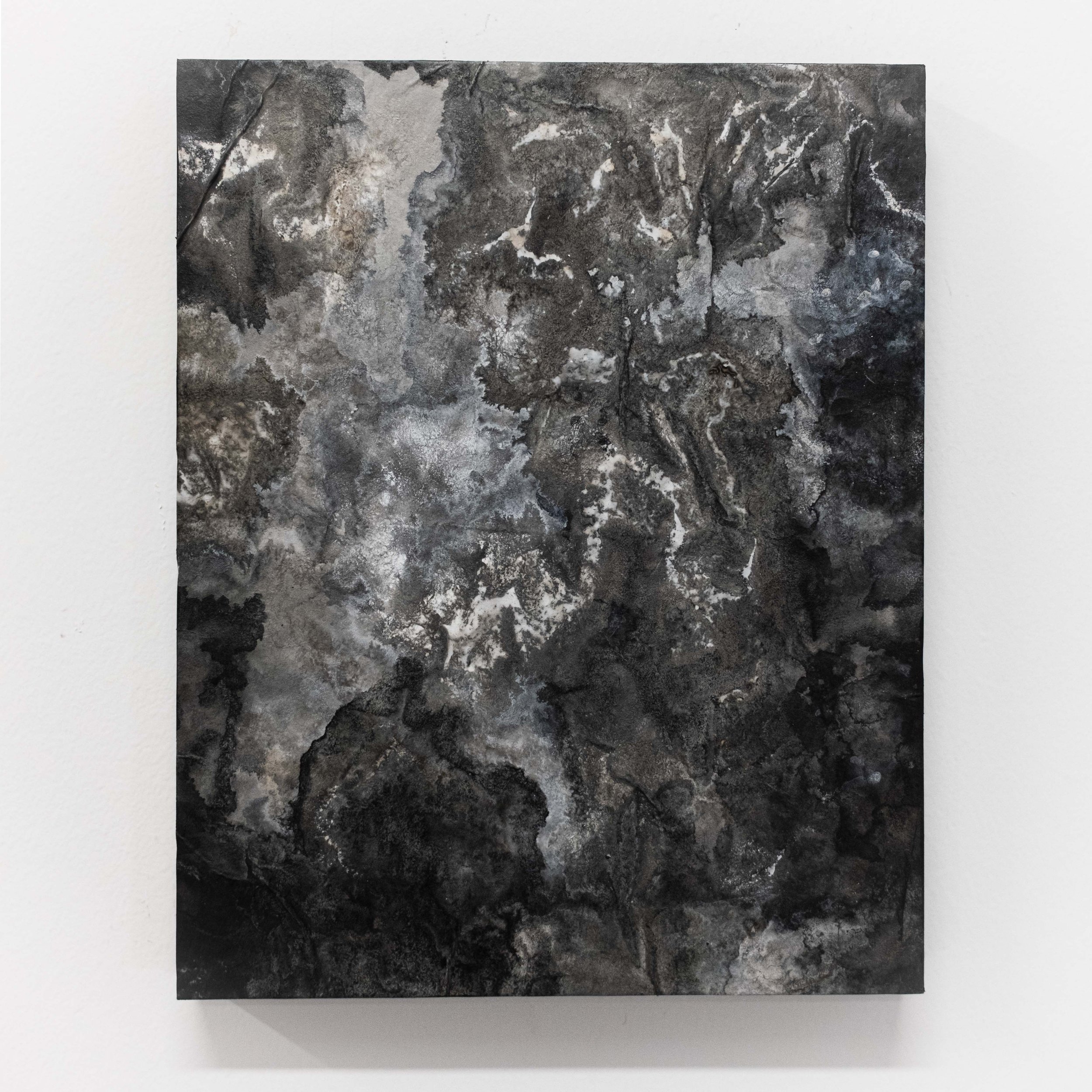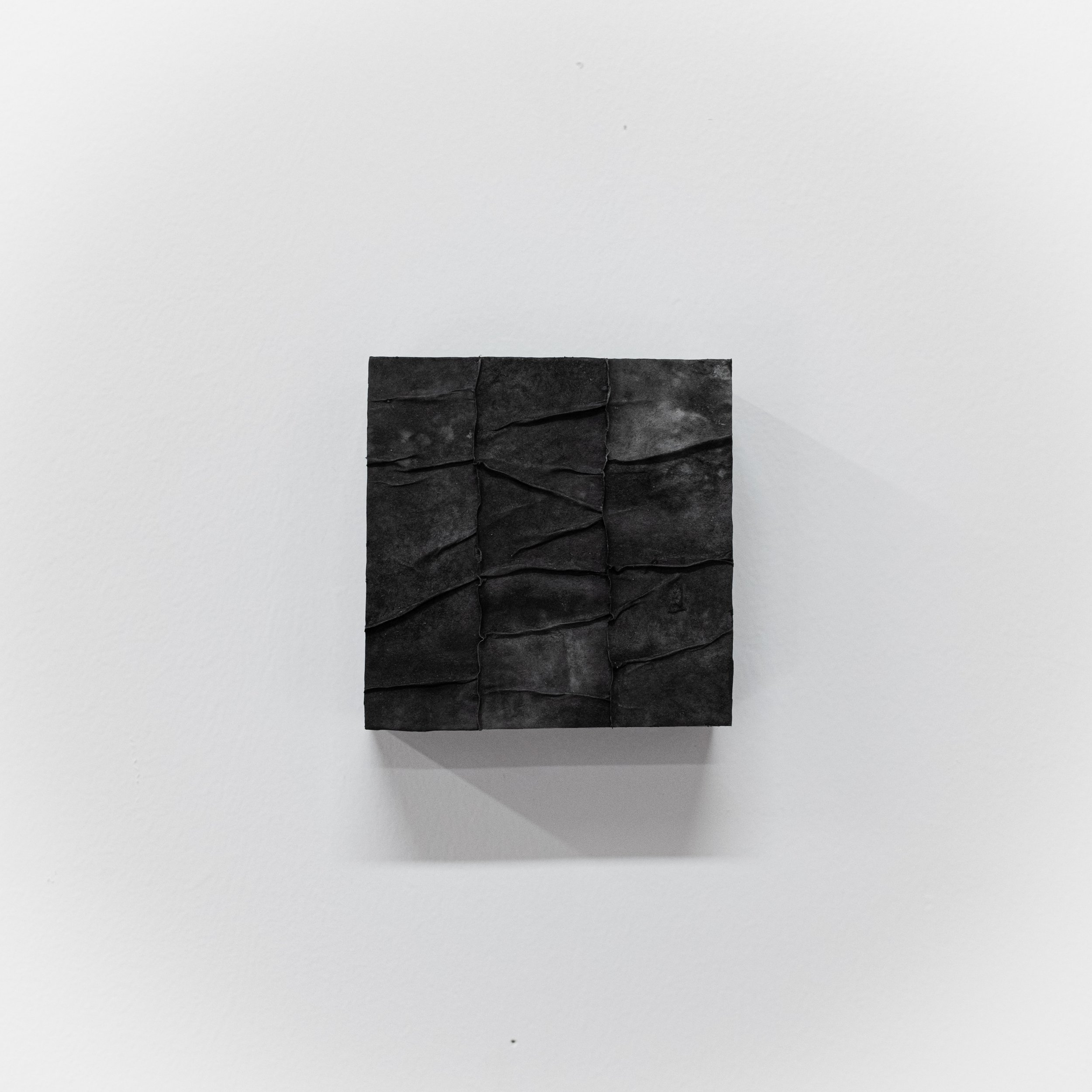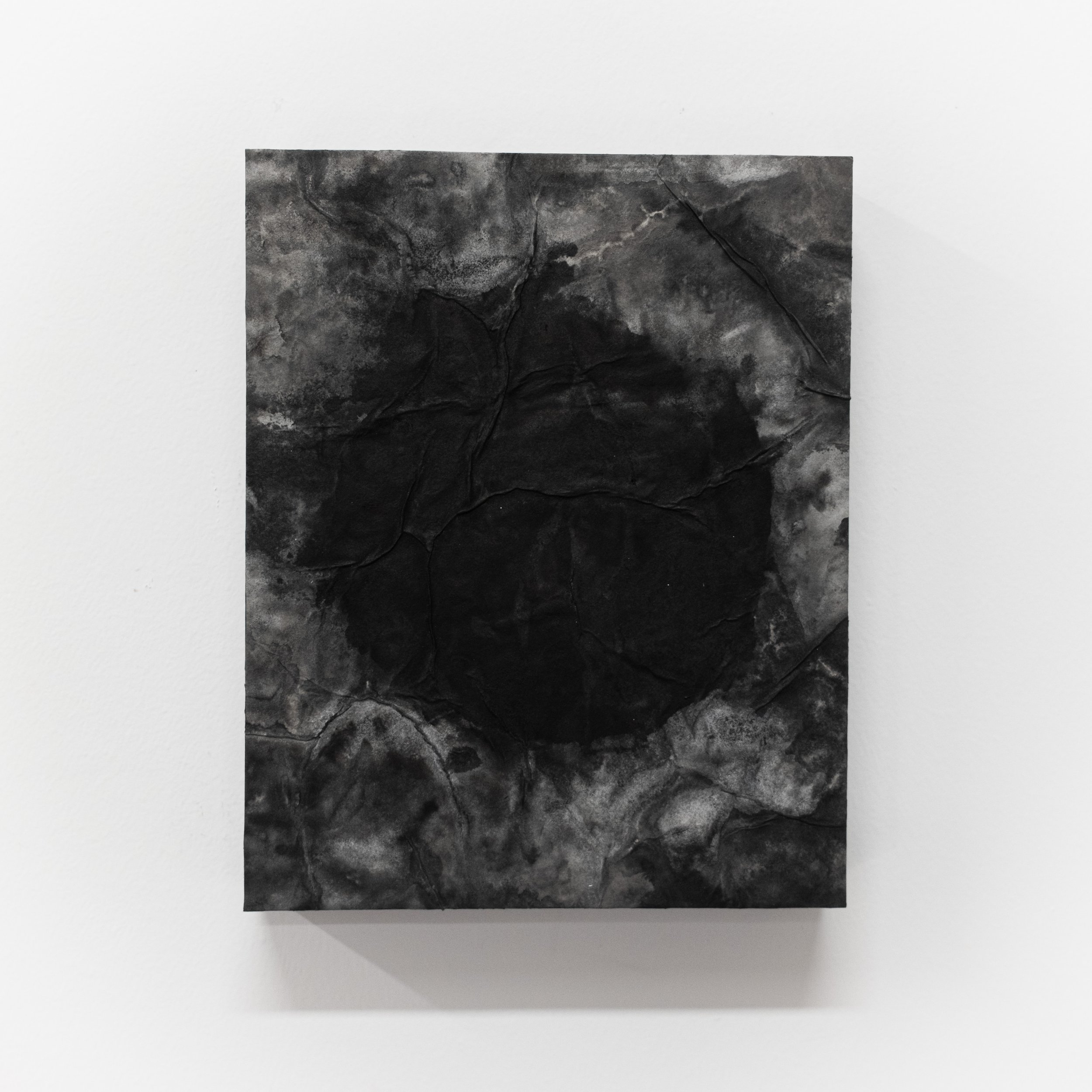HOME IN THE DISTANCE
By Joshua Hagler
DECEMBER NIGHT
by W.S. Merwin
The cold slope is standing in darkness
But the south of the trees is dry to the touch
The heavy limbs climb into the moonlight bearing feathers
I came to watch these
White plants older at night
The oldest
Come first to the ruins
The water flows through its
Own fingers without end
Tonight once more
I find a single prayer and it is not for men
ALONE I STARE INTO THE FROST’S WHITE FACE
by Osip Mandelstam, Translated from the Russian by W.S. Merwin
I am alone staring into the eye of the ice.
He is going nowhere. I came from there.
A miracle: the plain ironed to the end
of time, pleated without a wrinkle, is breathing.
The sun squints, a starched pauper;
calm grimace, source of calm.
The forests stretch into ten figures, almost as they should be.
The eyes bite on virgin bread, on snow.
Telegraphing Movement | Mixed Media, Paper & Wood | 10 x 8 x .75 In. | 2022
HOME IN THE DISTANCE
As much as they are paintings, Samuel Staffan’s intimate coruscating works comprising his exhibition Imagined History are poems, songs, snapshots, fossils, or, even as the title of one particular series suggests, “field recordings.” They are mimetic in approach and scheme. In the immediate sense, they materially harness something of the natural forces toward which the artist is personally compelled, but there is another, I think, more important way; the process in its totality is not only to do with the outer appearance of the individual artwork but with an overarching ecosystem of creative endeavor in which a painting, photograph or even audio sample plays just one part. In some sense, it is probably true for all artists that making art is just one part of an overall imaginative interface with the world, but rarely, I think, do we consciously schematize the processional cycle of subject and object so thoroughly.
To understand what I mean, it’s useful to think of each work as an iteration of a possible world as opposed to the conclusion of, say, a line of research or a narrative of some kind. They are not functioning symbolically but actually. Each iteration is a possibility in the vast sea of possibilities for a world either mostly forgotten or largely nascent—or both. This is to say, the work situates itself within a blur between worlds, or perhaps better, within the blur of one seismic world in which time—or an experience of time—breaks down. One world in which the scale of things is undifferentiated, unsettled, not yet determined.
In the cosmology of Staffan’s experiments, everything is available for use, not as matter, but as energy, and because it is an open system, its entropy is limited. From an encounter with winter comes a sketch or photograph which aims to hold the encounter, to hold the winter as it were, as opposed to holding the tree or the snow. This ecosystem desires for one medium to translate into another, one encounter to translate into process, and so on. What can be captured optically might have an audible counterpart, for example. It implicitly asks certain kinds of questions. What does the sound of footfall in the snow look like? What does the resulting footprint sound like?
Winter Passage IV | Ink, Paper, Acrylic and Wood | 10 x 8 x 1.5 In. | 2021
Winter Passage III | Ink, Paper and Wood | 4 x 4 x 1.5 In. | 2021
Notice that so far I’ve mentioned nothing about who Samuel Staffan is, nor have I tried to situate him as an artist persona in a milieu or history. He could be located in these constructs, like it or not, as we all could, but, in some sense, his approach is that of an amnesiac. The amnesiac asks of the cold slope, the darkness, the magpie, what is this passage into which I descend and who am I to it? The amnesiac asks for guidance, and all which cannot be named points the course. Intuitively, he knows this. The course that water takes, for example, plays a direct and actual role in determining the course of an individual painting, and, by implication, the body of work these paintings comprise. Black and white, he intuits, are the colors of unreachable distances, the past as it appears before the time of one’s own birth, the colors of sleep, dream, and death. White: the eventual result of all available light in the universe crossing its distances into the eye. Black: when it has gone from it. There is the sense, to the amnesiac, that everything as it happens, has already happened, and yet all experience is just one possibility for a self which hasn’t yet been born. One possible self within the “throng of selves.” One epigenetic iteration among all past and future iterations.
Northern Spirits | Ink, Paper, Acrylic, Staples and Wood | 4 x 4 x 1.5 in | 2021
The River’s Memory | Ink, Paper, Acrylic and Wood | 20 x 16 x .75 in | 2021
When Dimitry Andreyevich Lebedev was born in Vyshny Volochyok, a small Russian town in the summer of 1998, he was given to an orphanage before being adopted. He was not yet Samuel Staffan. Samuel Staffan wouldn’t exist for another eight months, now the son of a loving Michigan couple who had lost their only biological child some six years prior.
The more I look at and think about Staffan’s work, the more important these facts seem to me. Now the exhibition title Imagined History comes into sharp focus. If this wasn’t intentional on his part, then the title is all the more meaningful for it. A lifelong painter myself, I would be nearly 40 years old before I came into the understanding that, all along, painting had been a kind of secret attempt at recovering some sort of lost identity, lost memory, in a world which seemed well beyond the possibility of my belonging to it. Though it would be wrong of me to project an identical motivation here, I can observe some things in the work that bring me to this manner of thought.
Field Recordings (Vermont I) | Photographic Print, Acrylic and Wood | 16 x 20 x .75 In. | 2022
First, I return to the titles: “The River’s Memory,” “Drift,” “Northern Spirits,” “Winter Passage,” “Gateway,” etc. The photographic series “Field Recordings.” In each of these, the identity of the work comes from the “field,” from the ebbs and flows of seasons and geological features, of time and space. They are not the words we use to make assertions about ourselves from an ego standpoint. Only if self transcends the kinds of personae we feel pressured to invent for social status in the contemporary world of slogan and brand do we tend to appeal to the natural world, the world outside of our bodies, to which we accord or attune ourselves. But the very tendency that we might seek the self in the natural world seems to me always to imply a search which is ongoing. The task for the artist, then, is not, as is popularly believed, to announce and promulgate oneself all at once as a dog might urinate on a fire hydrant, but to allow the bread crumbs of the soul to reveal themselves gradually, as in the development of a language, which, in time, is to become deeply relevant to the inner reality of self.
What drives such a search via art making seems a primal yearning, a kind of copoiesis between the individual consciousness and that mysterious absence better felt than intellectualized. It is a search born from the mere hope of communion with that which has always been unreachable.
Black Hole Sun | Ink, Paper, Acrylic and Wood | 10 x 8 x 1.5 In. | 2021
The manner in which the organic synchronous passages within Staffan’s individual works determine, to a large extent, and almost paradoxically, the warm personal encounter we have with them might have, in part, to do with what is often a 10 x 8-inch portrait orientation, giving us to thoughts of family portraits. But I think it’s more than that. If the work were at a scale diminishing the individual body (let’s use a piece like “Black Hole Sun” as an example) we would feel at a distance, too cold and oppressed to linger long. But at a scale requiring that we lean in, one almost sees a face behind a veil, beneath water, in the fog. We experience a kind of hovering of the object itself and in our mind’s eye. We recognize something here because, I think, that “something” is universal. Formally, it has to do with the way in which apparent simplicity allows for projection on the part of the viewer, in which the image reflected will give our innermost experience of the world back to us. Metaphysically, if we want to go there, I might say it has to do with what every poem I’ve ever bought from someone homeless has been about: Mother.
If this seems like a sudden and far reach, perhaps it is, but if these works are, as I suggested, iterative possible worlds, then they are also iterative possible lives in a kind of eternal recursive return, an idea which shouldn’t just be attributed Nietzsche or Bill Murray, but to religion and mythology broadly (windows into human psyche) and, lately, to the science of complexity systems (uncovering phenomena hidden by space and time). Staffan’s individual works are warm in feeling because their implicit reconciliatory yearning is of a kind we all experience.
Mother is the word for the one who gave us individual life and also for the one providing safe passage into the next. It is not necessary to be keen on the idea of an afterlife, or past and future lives, but simply to yearn for home, which is probably never really a place so much as a feeling. It is this feeling that the amnesiac through his winter passage follows, not out of faith in chance or randomness, nor in signs and symbols, nor divine intervention, but out of a simple reliance on sensate aptitude, a poet’s aptitude. Poetry gives as much direction to a life as rationality, but, in the case of poetry, the shortest distance between two points is to relish in the distance itself. Poetry is the voice of the amnesiac, the transpersonal self, and, sometimes, of Aletheia, that ancient Greek concept of recovered memory, that which had been lost to the previous life and unveiled always and only by the lone poet. What in history is imagined, then, might well lead, in time, to its unconcealment.
Gloaming Blossoms | Mixed Media, Paper & Wood | 16 x 20 x .75 In. | 2022







